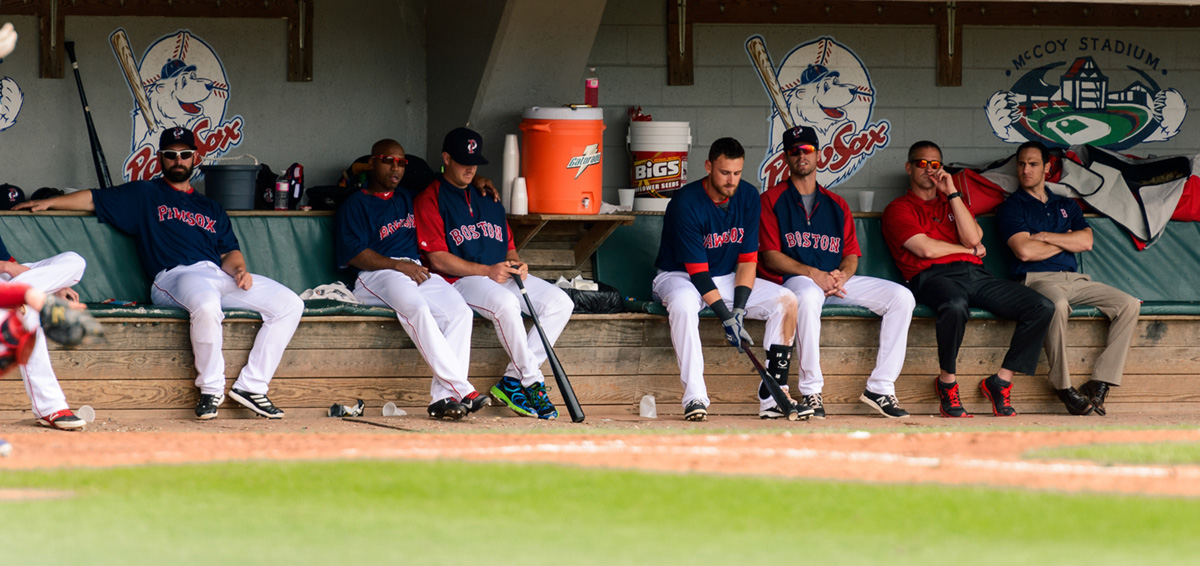
PawSox dugout at McCoy Stadium. Photo (cc) Eric Kilby
WPRI: Lucchino responds to skepticism over proposed Providence ballpark
Lucchino, one of the team’s new owners, said the project is a clear economic engine for the local economy, and not just through baseball.
“We have to build a ballpark that has multiple uses, that can attract football and could attract concerts, that can have some art events at the thing,” he said. “Make it an major civic center for Providence.”
[…]Lucchino believes the new park will not only boost the economy, but also revitalize downtown Providence. He hopes to bring a million people to the capital city by generating small businesses and jobs.
PBN: Pawsox greeted by skeptical I-195 commission and audience
Owners of the Pawtucket Red Sox presented a detailed plan for moving the AAA team to downtown Providence Monday, earning a skeptical if not critical reception from the commission that controls the site the team wants for its new ballpark.
In questions posed during the meeting of the Interstate 195 Redevelopment District Commission, commissioners questioned both the public cost and the tax benefits of the proposed development, and whether the state could find a more effective use for the site to attract highly desirable high-tech or life sciences development to the I-195 lands.
The question of other uses seems odd, so far as I know we still haven’t found a way out of the federal requirement for park land at this location.
RI Future: Progressives, conservatives unite to fight downtown ballpark
An unlikely coalition of opponents to the proposed downtown Providence stadium deal greeted new PawSox owner Jim Skeffington as he exited his chauffeured Ford Escalade and quickly entered the Rhode Island Commerce Corporation (RICC) offices at 315 Iron Horse Way.
Representatives and embers of the RI Tea Party, The Republican Party, the Progressive Democrats of Rhode Island, The Green Party, Direct Action for Rights and Equality, Occupy Providence, The Rhode Island Sierra Club, RI Taxpayers, The Rhode Island Libertarian Party, and the Capital Good Fund stood side by side to take a stand against corporate welfare.
Visit the link to see videos of speakers.
ProJo: Pointed questions, sharp criticism aimed at PawSox stadium proposal
After the first public meeting Monday about the PawSox owners’ proposal to build a stadium in Providence, Rhode Island Commerce Secretary Stefan Pryor and I-195 Commission Chairman Joseph F. Azrack said state leaders must craft a deal more “appropriately balanced” and more fair for taxpayers if the project is to move forward.
“The financial arrangement that is proposed by the team’s ownership involves a substantial public investment, yet the proceeds for profits from the stadium primarily return to the owners,” Pryor said. “The important question to ask is whether there might be an alternative financial arrangement that might be more fair and might enable taxpayers to feel less of the burden.”
WPRI: Raimondo balks at pitch for new PawSox stadium
The new PawSox owners’ first stadium proposal is dead. Will a revised one have more success?
That was the question of the hour late Monday after Gov. Gina Raimondo and her top aides poured cold water on a request from new Pawtucket Red Sox President Jim Skeffington for $120 million in taxpayer subsidies and free downtown land to build the AAA team a new stadium.
“From what I understand of the owners’ initial proposal, it appears that Rhode Island taxpayers would pay most, if not all of the cost of building the new stadium, yet the owners would stand to receive all of the profits,” Raimondo said in a statement Monday evening. “That isn’t fair for Rhode Islanders.”
RINPR: Owner of Victory Place Suggests Alternative Site for PawSox Stadium
The owner of the Victory Place parcel near Davol Square, JAG Investment Realty, on Tuesday suggested the site as an alternative location for creating a stadium for the Pawtucket Red Sox.
“JAG Investment Realty strongly believes that keeping the PawSox in Rhode Island and building a ballpark in Providence is an extremely important endeavor,” said a company spokesman, Bill Fischer. “We are also respectful of the new ownership team led by Mr. Skeffington and their current plan and understand our location is not their first choice. That said, we also want it to be known that there is a highly qualified alternate location in Providence in the event that the current site does not meet final approval for any reason.”

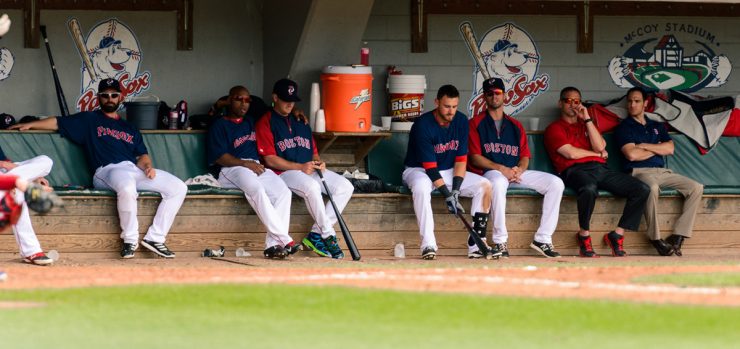
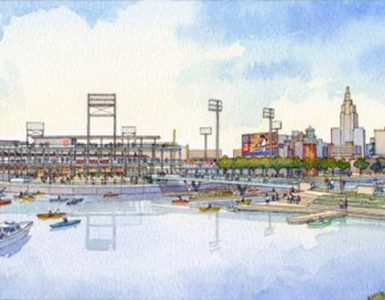
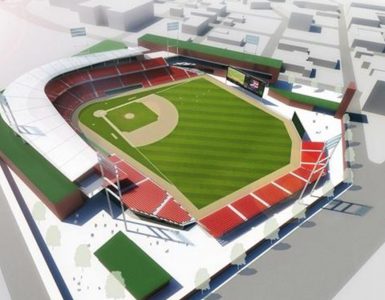
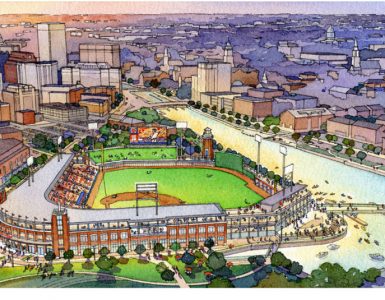

http://www.golocalprov.com/news/exclusive-new-pawsox-stadium-location-emerges-in-providence
Rendering of the proposed Victory Plating site.
the consensus in studies preformed on the economic impact of major league baseball stadiums is that not only do they not provided the advertized benefits they actually cause incomes in the area to decline. Keep in mind this is major league, and we are talking about here a minor league team that has no where near the name recognition or drawing power of a major league team. So this stadium deal would not only cost the $2 million a year the owners say, it will cost $4 million in lease payments, of course the free land, and if they do pay for it i am sure they will not pay market value, the loss taxes in providence and the cost of public services for game days, and on top of that less money staying in the state, this is close to a $200 million dollar transfer from the state to these millionaires for a team that is only worth $20 million, this deal should not be approved in anyway shape and form. No money should go to this boondoggle.
Some notes from a study that was a comprehensive look at studies done on stadiums. Economists Dennis Coates and Brad Humphreys writing for Econ Journal Watch in 2008:
1. Much of the consumer spending associated with professional sports
comes out of the entertainment budgets of local residents. When a
new sports franchise appears in a city, local entertainment spending on
sports increases and local entertainment spending on other activities
like movies, bowling, etc. decreases. The effective “local spending multiplier”
on activities like bowling and attending plays or concerts is higher
than the multiplier on professional sporting events because the owners
of bowling alleys, theatres, and restaurants, as well as the employees
of these establishments, live in the community while the owners and
highly paid players (who receive a majority of team’s expenditures) on
professional sports teams generally do not. Since spending on professional
sports teams substitutes for other local consumer entertainment
spending and has a lower local spending multiplier, professional sports
can reduce local income rather than increase it.
2. No matter what cities or geographical areas are
examined, no matter what estimators are used, no matter what model
specifications are used, and no matter what variables are used, articles
published in peer reviewed economics journals contain almost no
evidence that professional sports franchises and facilities have a
measurable economic impact on the economy.
Jon- Have you ever visited a Major League Baseball stadium? Specifically Fenway Park? Its an absolute breathing ground for bars, restaurants, retail and more that has become a tradition, including one of the most famous streets in the Northeast, Yawkey Way. I know the Pawtucket Red Sox are not the Boston Red Sox, but it could become “South Yawkey Way” with similar traditions that can build into the future. Maybe I’m dreaming a little, but its completely feasible. Pawtucket Red Sox is part of one of the greatest sports organizations in the world, there is plenty of opportunities with baseball alone, never mind concerts, festivals ect.
the fact that a second proposal exists proves that PVD is desirable to build in. #findthepositive
Gio, please reread the quote from the study, yes it might help the surrounding area, but it will not help the city overall as it will just be shifting that economic activity to around the stadium on game days and hurt the other parts of the city, there will be no net gain, and money would be leaving the city as players and owners do not live in the area and the jobs that it creates are low wage. I also do not think providence is in any lack of bars or restaurants. We have a thriving culinary scene without a stadium and do not need one to support it.
Gio, and to your festival point, a public park will suit a festival just as well as a ball park, probably better. Remember the gravity and x games in the city before gtech and waterplace condos were built, all done on regular open space.
But it isn’t a new team, the PawSox already exist in this market. The supposed positive impact the owners are touting is blunted by this fact, but so is the supposed negative impact.
Every time I hear Larry Lucchino speak about this proposal, I think of a quote from The Princess Bride: “Life is pain, Highness. Anyone who tells you otherwise is selling you something.”
Some Comments:
“The question of other uses seems odd, so far as I know we still haven’t found a way out of the federal requirement for park land at this location.”
This is not difficult with 1) the land containing the stadium and the immediate area designated as a park, a walkway and landscaping around it 2) US Congressional delegation support.
While “…one of the greatest sports organizations in the world” is not true (Boston is hardly a world class anything), a Providence Red Sox located in the heart of the riverfront is better than Fenway Park…and Pawtucket is no anyway in Providence’s class. Automatic plus.
Finally, while “…almost no evidence that professional sports franchises and facilities have a measurable economic impact on the economy” is true, it is the fact that it would be an attraction for investors in the I-195 land that is its greatest asset.
Steve, developers are not going to magically decide to build because there is a AAA ball park there, the only thing the park will do is make them want generous tax breaks since the ballpark got them. The idea the owners are pushing that hotels will be built because of the park is ludicrous, no one travels to see a AAA game, and many times the players do not even stay over night, they bus in and bus out as soon as the game is done. Yes, lets just ignore what happened with every other publicly subsided stadium, this small minor league team will be the exception even thought the public subsidy is way out of wack with other stadiums and therefore the return would have to even greater for there to be a positive effect from it. I guess people that think that way are true Rhode Islanders, the same people throwing their money down the slot machines. That land is valuable, we should not rush to develop it, there is one chance to get it right, for goodness sake they are not even done building the infrastructure down there yet and people want it fully developed already, the project is not a failure without this stadium. People will build, lets not just give it away to the first person that sniffs around.
Jef- for the state this will be a money loser, as the McCoy revenue will just be shifted to providence, but then the state unlike now which is only paying i think $100k or so for McCoy will be paying $4million a year for this new stadium, they will basically be paying off the loan and interest and then some for this stadium, which is why the owners saying this is privately funded is a complete joke. And as all the studies found, the stadium will not generate new spending, people will just be spending money at the park instead of money at the movies, money on fed hill, money elsewhere in the state. So the net effect of moving this stadium will be a bill for the taxpayers of $4 million dollars for 30 years. The same for providence, they want no taxes, that’s about $3 million a year, again for 30 years. The city will get a bit new revenue since again, state wide money spent will be moving to providence, but that will not overcome the loss of the $3 million dollars a year from no taxes, the money spent on police detail for game days and so on, it will be a net money loser for the city as well, and the owners will be laughing all the way to the bank.
jon, tax breaks aside, you don’t think people who wouldn’t otherwise be spending money at any of those places you claim will lose business to the ballpark would end up doing that? I think the ballpark would increase money spent in Providence not just shift it. The people who go to McCoy will now be going to Providence. People who drove through Providence on 95 to get to McCoy. People stopped in Pawtucket without continuing on to Providence. Yes, that means that money won’t be spent in other RI communities, but how much is it now with McCoy being in a desert of sorts. People drive into Pawtucket, go to a game, and drive out of Pawtucket because there’s nothing else there. That will still be the case for many people going to a game in Providence, but not everyone. And you’d get people who wouldn’t be as likely to attend a game now going, people who might shift some of their money around, but might extend it to include baseball.
Jim, Again, all these studies show people don’t extend their spending to include baseball games, they keep their budgets and cut something else. Why would providence be different from every other city that has done the same thing? And McCoy is 5 minutes from providence, people who would eat out before a game are probably already doing that in Providence, and most people just get concession stand food in the park. Plus, the ticket prices and concession stand prices will not be at McCoy levels, they will be much higher in the new stadium, meaning the shift will be greater. So other business get hurt, the pawsoxs get the benefits and the state pays through the nose for it.
jon- I’ve never heard of people eating in Providence before a Pawtucket Red Sox game. And its not 5 minutes to McCoy. I see your point but, its exaggerated a tad.
I’ve never ate in Providence before a PawSox game.
If we were thinking purely GDP, then it’s likely that we would need to attract higher attendance from a wider geographic area to see total growth. That seems plausible, if not to a massive degree.
If we were thinking spending outside of the stadium itself, a location in PVD could very well shift spending from inside the stadium on hot dogs and nachos to outside of the stadium in area businesses to a far greater degree than was ever plausible in Pawtucket.
This means less potential profit from concessions for the owners per attendee, and even though there’s the same total economic activity, it could be more broadly spread.
I have no doubt that strong place-making makes the surrounding land more attractive and thus more valuable (although let’s not be silly and talk about how this is attracting biotech… it’s just making the city a broadly more pleasant place and that neighborhood more exciting/viable). I think denying that is just a bit silly. What it really comes down to is *how much* more attractive, *how much* spread of economic activity, and *relative to* what other potential investments?
As I wrote in my post:
“I can absolutely think of better ways to spend state dollars, but I also realize that the trade-off is not that simple. Rhode Island is not facing a windfall of $85,000,000 and trying to decide what to do with it. A stadium that keeps the PawSox in Rhode Island inspires emotion. The willingness to create these dollars for this purpose may be far higher than alternative uses. The correct counterfactual is not necessarily supporting 111 Westminster (a better plan for less). It is not necessarily better school buildings. It is not necessarily meaningful tax benefits for rooftop solar power. It is not lowering taxes, building a fund to provide seed capital to local startups, a streetcar, dedicated bus and/or bike lanes, or tax benefits to fill vacant properties and homes. The correct counterfactual could be nothing. It could be all of these things, but in much smaller measure. It is very hard to fully evaluate this proposal because we are not rational actors with a fixed budget line making marginal investment decisions.”
http://blog.jsonbecker.com/2015/04/acceptable-terms.html
Jason- But do those benefits, if they materialize, justify a huge outlay from the public to a private group? Talking about place making, a well designed park, maybe going with providence as the creative capitol, you make it a sculpture park. That is place making too, and would attract business better i feel than a baseball park. And it would be public money for a public space, not a private space. And traffic is already horrific down there as it is during rush hour, why would a baseball park that will just make it worse make business want to move there? If you have been following this you sure have seen some of the business owners talk about the stadium, and in fact they say they would not make a decision to move somewhere because of a ball park, that would be a stupid business decision.
And i should point out that i would not be against a public backed loan, like 38 studios got, this deal which is just the state paying for the stadium is the problem. A publicly backed loan so they get a better interest rate and the owners pay it back, if they default the state gets the stadium and the team. but giving them straight cash payments for little to no benefit is just a welfare check to these owners.
I definitely have never eaten in Pawtucket before a PawSox game.
I think we can all agree. The current deal put forth by the Sox ownership sucks! I also think we can all agree that there are countless studies that show ball parks are not always the economic generators owners claim they are.
However, if you look at the cities the Sox are emulating (Charlotte, Durham, Toledo), those ball clubs relocating to those places are considered a success. But the ballpark was just a part of that success. Their ballparks were not seen in and of itself as a direct economic generator (despite what Skeffington wants us to believe) but it created an anchor, a sense of place that people were able to point to with some sense of pride. I am not sure if you can attach a dollar value to that. Businesses that followed or are following in behind associate their place along with the ballpark. It may not be their reason for coming but it’s presence is noted as an indicator of stability and a commitment by that city for the long term.
So let the sides negotiate. See what happens. The biggest impediment to this whole process seems to be the rampant negativism of any deal. This constant mantra of “we are going to get screwed” is detrimental to our ultimate goal; that Rhode Island and Providence are good places to do business. Do we really want to send a message that any business coming in here that may be looking for any municipal or state assistance is going to be marked as a blood sucking pariah living off the teat of the taxpayer. That their presence will always be looked at with a sneer and a comment about some backroom deal. Why do that when there are 49 other states and their taxpayers offering assistance and projecting a positive vision of themselves.
If the final deal is not fair, I will be one of the first to say walk away. Until that final proposal is out there I will remain optimistic that we can make a deal but realistic that the Pawsox may be going elsewhere if an acceptable deal doesn’t happen.
Jon –
I agree that pushing that hotels will be built because of the park is silly, I agree the land is valuable, and I agree that pro stadiums at all levels have minimal direct economic impact.
The difference here as I see it is that 1) it is in the heart of Providence – a nationally recognized city- not some vanilla mid-sized city or suburb, 2) it would be a tangible and impressive physical signal that the area is worth investing in, and 3) it will add to the already vibrant downtown that does give corporations and tourists another choice of entertainment.
I argue that we should make this work. This project is not a slot parlor or a gaming company.
P..S – I am from Providence – not “RI” (big difference) and spend half the year in over 35 cities across the nation.
If I’m trying to sell this project as a year round facility, I would have had my design firm make that a little more obvious. The current design is not a full year round entertainment district, and that’s a problem for me. They are selling the project half-ass.
You can’t just say “yeah, we will host hockey games too”, and the project qualifies as a year round sports facility. Why not incorporate a large “four seasons room” space, similar to a covered street that can be blocked from the wind and have heat lamps installed. Some retail and restaurants could open to this sheltered space, and have some outdoor seating areas. Co-locating a smaller entertainment space for intimate concerts, comedy shows, theatrical performances, and gallery showcases would be another way to bring people there in the off-season.
Creating a list of “partner organizations” that have committed to hosting an event(s) at the new facility would also show skeptics that they intend on being a year round facility. What about sponsors? Show us that the region’s private business community is lining up to sponsor, buy advertising, and reserve luxury boxes. Show us an increase in season ticket sales. Show us commitments.
Co-locating year round features may be the key to the project though. What about a destination fitness facility, for the Sox, college teams, other municipalities, and public living downtown to use. This would bring people in all year, and most of the time at odd hours — creating an image of foot traffic at the complex. Some features such as climbing walls, olympic sized swimming pool with stands, raquetball court, indoor tennis courts with viewing areas, etc. would add liveability to the city and make the area a year round destination for either tourists, sports spectators (families), downtown residents (which is slated to increase by over 1,000 people by the time the first pitch is thrown at the new stadium), or both. Other year round facilities/features, could be a bowling alley themed restaurant (which are a lot of fun; Boston has a couple, there is a franchise called Lucky Strike).
In order to give up less of their original proposal (and secure the riverfront parcel), the ownership group could increase the size of the project towards 95, and change its scope on non-river front parcels to more of a year round facility. The parcel across the street that was labeled “future development” on the original renderings could house many of these features, but the key is to have people walking around AT the stadium year round, not AROUND it. They could achieve this through partnerships with other developers.
Examples of Year-Round Features (and guestimate vistors):
Event Space/Theatre/Hall = 60,000 visitors per year (600 person capacity space)
On-Site Hotel with small Conference Center (200 rooms) = 108,000 visitors per year
Destination Fitness & Sports Center = ~100,000 visitors per year
First Night Providence = 80,000 visitors (has been as high as 100,000)
3 PC hockey games = 18,000 visitors (triple the average attendance)
3 Brown hockey games = 6,000 visitors
Providence Winter Carnival type event = 50,000 visitors
Bowling Alley = 50,000 visitors
Just these brainstorming ideas gets you half the visitors that the stadium would bring in according to Larry Luchino (and a large amount of this is off-season visits), at a substantially smaller price tag… even if the City owned and constructed it all. The best part of it all is that it would include a lot of different features, diversifying the revenue and protecting the City. By incorporating the sports center, which would rely on town/city/college/club sports, which are largely recession-proof, and an established AAA ball club, there will always be baseline demand for the features of the district.
Without this being a total “entertainment district”, it’s tough for me to see the upside for the City. Versus, for example, showing a plan that would drive 2 million people to providence YEAR ROUND to a mixed use, diversified development headlined by the country’s most successful minor league AAA baseball franchise.
KCB just described what I attempted to explain earlier. HUGE POTENTIAL
We don’t have to imagine what the economic impact to the surrounding area. The wastelands around the civic center and McCoy tell the tale for us.
I don’t know about wasteland. I see Providence Coal Fired Pizza, Rosalina, Trinity Brewhouse, and many other restaurants fill with people during PBruins games, PPAC shows, the circus, various Irish dancing and cheerleading competitions, etc.
Exactly, Jason…in fact, it is just the opposite of a wasteland.
A wide area around the DD Center is pre and post a hockey or basketball event.
Hundreds of people eat before the games as far away as Federal Hill and Kennedy Plaza to Weybosset Street; including me.
The truth is the more events that bring thousands more folks into downtown, the better – it adds to the vibrancy, adds to vendor opportunities, adds to pre and post dining and/or drinking, adds to Waterfire Providence and other concurrent events, and ignites new culinary ventures.
Now, the area around McCoy, that is a wasteland.
The area immediately around the Dunk is indeed wasteland feeling, that is due largely to the built environment. Hasbro? Wasteland. Fogarty? Vacant wasteland. ProJo? Single use wasteland. Public Safety Building Memorial Parking Lot™? Surface parking wasteland. Library? Hockey fans do not go to the library (I kid, they can read).
But indeed, Rosalina, Murphy’s, Shula’s, Celtic Lounge, Bravo, Trinity… as far afield as Union Station Brewery… Dunk event means you can’t get in.
Is the area around McCoy even zoned for restaurants and bars?
Agreed with recent posts, I’m always down city or on the hill for a meal before a game at the dunk. I would do the same for a Red Sox game for sure. The area around McCoy is pretty industrial and residential.
Yes, Sabin is a terrible street right now. Fountain is not much better. But like Jef said, just try and get into a restaurant down here.
Actually, if you really want to witness insanity, head to the Cheesecake Factory during any Convention Center event. Nothing against CF, but 2 hour waits are not uncommon. That’s insane.
Of course, there are problems with such a straightforward analysis such as the way this causes people to shift other leisure spending rather than generate new spending etc. But it’s not like people don’t show up, people won’t spill out to other businesses, and Providence isn’t more equipped to capture some of that. Sure, it may mean they spend the same amount overall but that’s just less on hot dogs in the stadium and more of the spending spread to other businesses.
The current deal is not worth it. I have a hard time seeing them walk back to a deal that is. But the people of RI do us no favors when they just deny the power of placemaking and the impact of bringing people into the city more frequently. We need to do more of both of these things throughout the city to succeed. This would be doing them on a grand scale and a ostentatious cost, but let’s not pretend no one eats at restaurants during events. That just makes you sound like the RIer who lives in Woonsocket and hasn’t been to Providence in 20 years.
Again, agree. Just one final comment on this…
It always troubles me when people use the “RI” frame of reference in any discussion regarding Providence.
First, Providence is the core of the Providence Metro Area – a 1.6M person area that includes all of RI (except the tip of Westerly) and southeastern MA – an area substantially bigger than RI. The entire metro (except the parochial suburbanites Jason cites) frequent city events…just like any other major metro area.
This should be the frame of reference in terms of mass transit, economic development, and other metro-centric planning.
Second, Pawtucket is a suburb OF Providence. So moving the stadium to downtown PVD is an added asset to the current situation – fan travel time is not adversely impacted and the ambience and access to other events and food/drink are greatly improved.
Essentially, Pawtucket is Providence in terms of metro economics, transportation, etc. The same applies to TF Green Airport – people fly to Providence. Period. We need to stop the parochial approach and apply a metropolitan – not state – view..